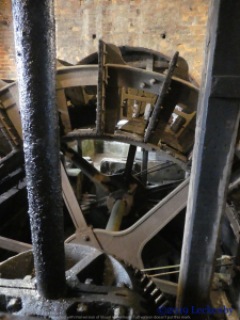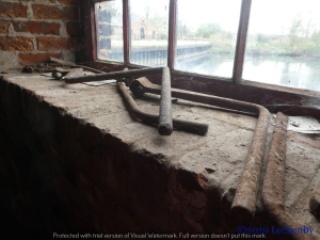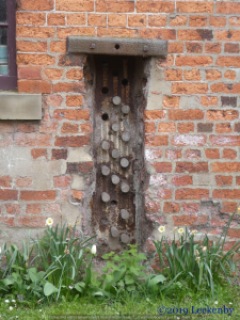Woodlesford Lock to Thwaite Mills
Maybe we should have carried on a touch yesterday. The towpath looked like you could moor just about anywhere along it, which would have meant we got away from boat engines running, but the footfall would have been similar no matter where we were.
 |
| Fishpond Lock |
A check on the website for Thwaite Mills said that the museum was open today so if there was room on their visitor moorings that would be our stop for today. Fishpond Lock had to be emptied first and as we ascended two boats appeared ahead of us. We vacated the lock, let the boats in and closed the gates behind them before our key of power was released. Half an hour or so further along, after passing novice rowers we ticked past the moored boats at the Mill, hoping that there would be space for us.
 |
| Thwaite Mills from the canal |
Freshly repaired mooring for a couple of boats sat empty. We pulled as far back as possible using our tyre fenders to keep the cabin side away from the high overhang and the Alde boiler flue out of harms way. A tiny bit of pruning was required for the pram cover to go up. We’d arrived bang on midday, just as the museum opened.
 |
| The Mill |
 |
| One of the wheels |
We were soon spotted by a member of staff and asked our intentions. Would we be visiting the museum, staying overnight, or both? Both was the plan and as it turned out a cost effective one. Entrance is normally £4 (a little cheaper for those with less or greyer hair than my own). To moor your boat here overnight is £5, however with this we got entry for both of us into the museum! A bargain, we might come again!
 |
| Cogs and turny bits |
 |
| Windlasses, maybe Halfie would like one |
Thwaites Mill Watermill, sits on a bend of the River Aire where water could be diverted to power large waterwheels. In 1641 a fulling mill was built on the site, large hammers pounded woolen fabric to help matt the fibres.
 |
| Plaster boot |
 |
| Chalk drying out on the racks |
In the 1820’s the Aire and Calder Navigation Company purchased the site and redeveloped it with mill, workshop, warehouse, stables and houses for the workers. All of this still exists apart from the workers cottages which were demolished in the 1960’s.
 |
| The mill from the weir |
The new mill was used for crushing. Chalk and flint, much of it used in the local pottery industry although a ton of powdered chalk was sent to Wakefield Gaol each month to be added to bread in the bake house. Rocks were dried, crushed, ground into powder, graded in water tanks and dried out for sale. Raw materials and the finished goods were transported to site by boat on the canal.
 |
| The smart house and gardens |
 |
| Fancy cornice |
A large Georgian house sits by the mill, grand in stature with gardens around it. Three rooms are laid out to view in Victorian and WW2 styles, an air raid shelter huddles in the garden where fruit canes and rhubarb grow.
 |
| Railway in the attic from the lift |
 |
| Chalk moved around to dry |
The watermill spreads over three floors, the materials moved upwards by lift originally until a new method was used to crush the stone in a Raymond Mill which was all enclosed so the process could be dry, a far more efficient method.
 |
| Unplug to drain the water out |
 |
| Flues took hot air around under the floor in the drying houses |
The old pits where the chalk was left to separate from water are still visible, the sediment would sink leaving water at the top. This was drained off through metal plates with big holes that could be unplugged to a suitable height. Fine chalk was moved up to the top floor where it was laid on racks to dry out. Across from the mill were drying houses with kilns under the floor, these were in operation 7 days a week. Chaps had to wear wooden over shoes to protect their feet from the hot floor as they dug our the dried material.
 |
| Air raid shelter for 12 |
 |
| The putty canning room |
In 1975 a big flood damaged the weir, once the final orders were completed, with use of a small engine, the mill stopped work. Today, sadly due to the recent floods both restored water wheels were out of operation. The small wheel had been repaired, but the repair hadn’t worked out. So we’ll have to return another time, maybe on our way back.
 |
| Ceramic colander |
A good day out, which came with a mooring at a very cheep price.
This evening the new blog has been tested, I just need to remember how to use OLW or work out how to post without it. WordPress has changed a lot in the last two years. We plan on going live with the new blog later this week. Those who subscribe via email will have to go to the new blog (still at oleanna.co.uk, but not just yet, we’ll let you know) and follow us again. Blog rolls may just update themselves, we’re not sure yet, but once we change where oleanna.co.uk points to, you should be able to still see our posts. We apologise for any initial problems in advance.
1 lock, 2.61 miles, 2 boats, £5 mooring and entrance, 1 bargain, 2 wheels, 1 weir, 1 museum almost to ourselves, 1 house, 1 ton chalk, 1d to get through the bridge, 4th day redone, 2 try out posts all okay.
https://goo.gl/maps/q6DuoKghumD2
Like this:
Like Loading...




















What an interesting day you had – a great read thank you. I reached your new site from the existing link on my blog page. Are you using WordPress? If so, for me the interesting bit is that I can see your photos, whereas I cannot see any on AreandAre’s and Teddy Tales blogs. Jennie
Hi Jennie! Congratulations you win a sausage roll for being the first person to comment on the new blog.
Yes we are moving to WordPress. The next few posts are being written on blogger so that they will show on both sites so that the Internet can catch up. Glad it has worked for you ready. AreandAre are they a WordPress or blogger blog? Glad you are still with us, enjoy your cruising this year. Pip
So is there going to be a post on the complexity of moving from Blogger to WordPress? The new layout looks nice
Thanks Tom. Mick might have to write that post as he did most of it. Still not fully moved, so there will be slight changes over the next week.